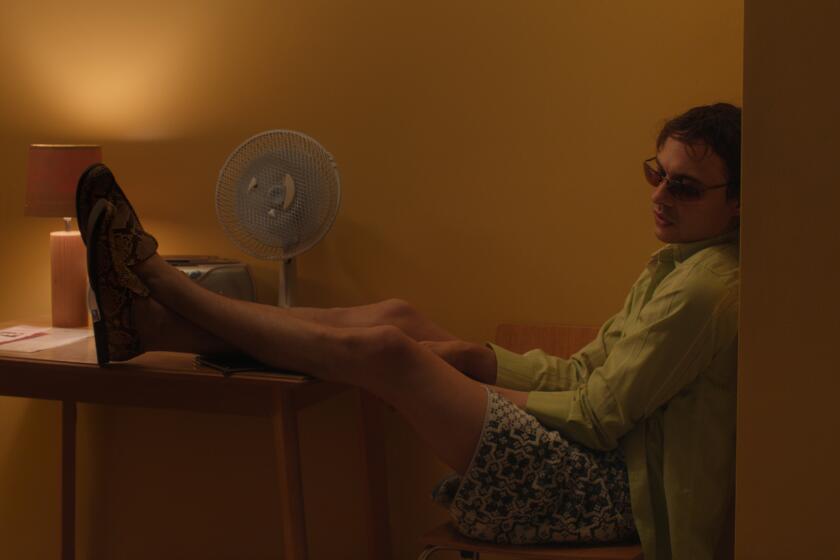MARCEL MARCEAU: LEGACY IN MOTION
- Share via
He has played 65 countries, made regular pilgrimages to America, returned to Japan seven times and to China twice. No language barriers here, because the language he speaks is universal.
Marcel Marceau, international mime and international treasure, alighted briefly in Los Angeles on Monday, not to perform or be silent, but to talk--articulately and at length.
Reminiscence was the name of the L’Ermitage Foundation’s Monday colloquy between a voluble Marceau and the foundation’s host/interviewer, film maker Annett Wolf, who, 20 years ago, had made the first documentary on Marceau. It was a meeting of old friends.
The event, part of the foundation’s Theatre Series ( salon -style evenings restricted to members of Le Club de L’Ermitage, a foundation offshoot), was a benign look at Marceau’s past and present and a glimpse at his future.
Central to the evening was the announcement that Marceau is deep into plans for the creation of a World Mime Centre in Ann Arbor, Mich. Looking fit and leaner than he has in years, Marceau conversed reflectively.
“I didn’t think I would become a mime,” he said, recalling his early childhood in Strasbourg. “I wanted to be a fireman, a painter. But I imitated Charlie Chaplin on the streets, with other children. It made me feel rich and poor at the same time.”
It was only after World War II (when he smuggled children into Switzerland to escape the Nazis and when his father was taken away by the Gestapo, never to return) that Marceau made his commitment to mime.
It was “ le coup de foudre “ (instant passion) when, “as a very young man,” he met the great master of French mime, Etienne Decroux, who taught him everything--”mime, acrobatics, language, tradition.”
He and actor Jean-Louis Barrault, his contemporary, both studied with Decroux, “but I stuck to mime,” Marceau said, at the same time acknowledging that the film “Children of Paradise,” starring Barrault as the great 19th-Century mime Debureau, had sparked a revival of interest in the art.
Marceau is a lover of Chekhov and Dickens--he claims his creation, Bip, with the top hat and flower, is an extension of “Great Expectations’ ” Pip, “a dream of Pierrot.” And his other unabashed love affair is with the United States.
“I came to America for the first time in 1955,” he said. “There were great plays, on Broadway, Off Broadway, great musicals, great films. I arrived with black curtains, one assistant and a scratchy gramophone, and there they were--Brooks Atkinson and Walter Kerr. I could not have written better (reviews). America became my second country.”
In the interim, he’s made 40 films, 14 for the Encyclopaedia Britannica (“a legacy”). He recalled his early reception in Los Angeles in the mid-’50s, Charles Laughton, Cary Grant and Groucho Marx.
“Groucho always invited us when we came to town,” he said. “In 1961 we did a mimodrama about a chomeur , a man who does not find work. I tried to explain what a chomeur is to Groucho, but he said, ‘A man who does not find work is not a chomeur , he’s a schlemiel. ‘ “
Legacy was a recurrent theme.
“In Commedia dell ‘ Arte, mimes spoke all the time,” he said. “French mimes were silent and left no legacy, except for Decroux and (French teacher/actor/director) Charles Dullin.” Marceau pointed to 1965 as the year that street mime began in America (“It was a silent cry”), remembered his teaming up in the ‘60s with Red Skelton and lamented the loss of films made of the two of them.
“In film,” he reflected, “you have to have the reality. In theater, the imagination takes over.”
And yet, in “Scrooge,” a recent British television adaptation of Dickens’ “A Christmas Carol,” Marceau plays every role by the skillful mixing of camera work and imagination.
“It was shot in 15 days in an empty space in the East End of London,” said Marceau, who is looking for an American market for the piece.
Another potential legacy is his desire to “bring to America what Marius Petipa brought to dance in America” by forming an international mime company in 1988--and an American one, both to be implemented through the projected center in Ann Arbor.
“I have to give back to America what America has given to me. Art can only be great if there is connaissance (knowledge) and money behind it,” he said in what sounded like a fund-raising plea.
“What is mime?” he reflected. “It’s not dance. It’s not slapstick. It is essence and restraint. Mime has an elliptical quality. Mime is to float in air like a fish in water . . . and weight is the sound of music.”
As an example he demonstrated the falling of a hand, limp-wristed, at the point of death, “not real, but an (artistic) echo of what life was,” then added astutely, “the public has a certain genius for feeling the drama--understanding the illusion.” Even at L’Ermitage.
More to Read
The biggest entertainment stories
Get our big stories about Hollywood, film, television, music, arts, culture and more right in your inbox as soon as they publish.
You may occasionally receive promotional content from the Los Angeles Times.










